八年级上册Unit8知识点总结
人教版八年级上册英语第八单元Unit8《重要知识点》汇总总结

人教版八年级上册英语第八单元Unit8《重要知识点》汇总总结UNIT 8 How do you make a banana milk shake?Section A(1a-3c)重点短语1. turn on接通(电流、煤气、水等); 打开2. cut up切碎3. pour…into…把……倒入……里4. put…in…把……放到……里5. how much/many多少6. one cup of yogurt一杯酸奶7. one more thing还有一件事8. take out拿出9. make…for… 为……做……10. cook for another ten minutes 再煮十分钟11. take out…from… 从……拿出……重点句型1. How do you make a banana milk shake?你怎样制作香蕉奶昔?2. How many bananas do we need?我们需要多少香蕉?3. How much yogurt do we need?我们需要多少酸奶?4. Finally, turn on the blender. 最后,打开搅拌器。
5. Finally,don't forget to add some salt. 最后,别忘了加一些盐。
6. Do you know how to plant a tree?你知道怎样种树吗?Section B(1a-Self Check)重点短语1. a piece of bread一片/块面包2. fill…with… 用……装满……3. cover…with… 用……覆/遮盖……4. place…on a plate把……放在盘子上5. one by one一个接一个6. mix…and… 把……和……混合7. at a very high temperature 在高温下8. see…as把……看成……9. cut…into thin pieces把……切成薄片10. for a long time很长一段时间11. have/eat. . . for breakfast 早餐吃…… 12. give thanks for 因……而感谢13. in most countries在大多数国家14. traditional food 传统食物15. on special holidays 在特殊的假日里重点句型1. What are the reasons for this special day?庆祝这个特殊日子的理由是什么?2. Now, it's time to enjoy the rice noodles!现在,到该享受米线的时候了!3. Thanksgiving is a time to give thanks for food in the autumn. 感恩节是一个感谢秋季收获的时刻。
八年级上册英语unit8知识点思维导图

八年级上册英语unit8知识点思维导图Unit 8的主要内容是关于地理和环境的,本文将为大家介绍该单元的知识点思维导图。
一、地理1. 地球地球是我们居住的星球,它是绕着太阳旋转的。
地球有赤道和两个极地,分布着不同的气候和环境。
2. 洲际板块地球表面由许多大陆和岛屿组成,这些大陆和岛屿都是由洲际板块构成的。
洲际板块是地球表层的巨大板块,它们可以移动并导致地震和火山爆发等自然灾害。
3. 地貌地貌是指地球表面地形和地势的形态。
地貌可以分为山地、丘陵、平原和河流等不同类型。
二、环境1. 自然环境自然环境是指不受人类影响的自然界和生态系统。
如山脉、森林、海洋等。
2. 人类环境人类环境是指人类生存和活动的环境,包括城市、家园、工作地点等。
人类环境好坏的不同会直接影响人们的身心健康以及生活质量。
3. 环境保护环境保护是指为了保护自然环境和人类环境所采取的各种行动,旨在实现可持续发展。
人类应该尽力保护大自然,减少对环境的破坏和污染。
4. 水资源水资源是地球最重要的资源之一,包括地下水、湖泊、河流、海洋等。
水资源的保护和管理非常重要,它们的污染和枯竭都会对人类社会造成严重影响。
5. 空气质量空气质量是指空气中不同污染物的浓度和组成。
空气质量的好坏直接影响着人们的身体健康和生活质量。
我们应该采取各种措施减少空气污染,改善空气质量。
总之,地球是我们共同的家园,环境保护是我们的责任和义务。
我们应该充分认识到环境保护的重要性,采取积极行动,共同营造一个美好的生态环境。
Unit 8 知识清单人教版八年级英语上册
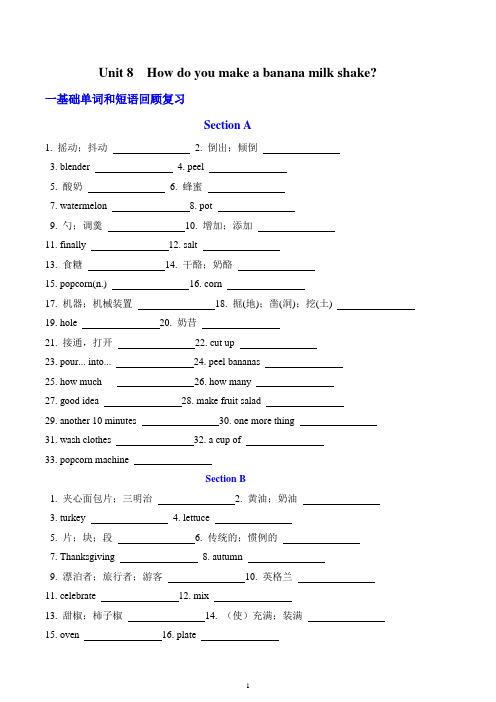
Unit 8 How do you make a banana milk shake? 一基础单词和短语回顾复习Section A1. 摇动;抖动2. 倒出;倾倒3. blender4. peel5. 酸奶6. 蜂蜜7. watermelon 8. pot9. 勺;调羹 10. 增加;添加11. finally 12. salt13. 食糖 14. 干酪;奶酪15. popcorn(n.) 16. corn17. 机器;机械装置 18. 掘(地);凿(洞);挖(土)19. hole 20. 奶昔21. 接通,打开 22. cut up23. pour... into... 24. peel bananas25. how much 26. how many27. good idea 28. make fruit salad29. another 10 minutes 30. one more thing31. wash clothes 32. a cup of33. popcorn machineSection B1. 夹心面包片;三明治2. 黄油;奶油3. turkey4. lettuce5. 片;块;段6. 传统的;惯例的7. Thanksgiving 8. autumn9. 漂泊者;旅行者;游客 10. 英格兰11. celebrate 12. mix13. 甜椒;柿子椒 14. (使)充满;装满15. oven 16. plate17. 遮盖;覆盖物 18. 接待;服务;提供19. gravy 20. temperature(n.)21. 一片面包 22. on special holidays23. 在11月的第四个星期四 24. one way to make turkey 25. 把火鸡切成薄片 26. cover...with...27. 用...装满 28. one by one29. 混合在一起 30. have a big meal二短语归纳milk shake turn on pour…into…a cup of yogurt a good ideaon Saturday cut up put…into… one more thing a piece ofat this timea fewfill… with…cover…with… one by onea long timehow many+可数名词复数how much+不可数名词It’s time (for sb.)+to do sth. First…Next…首先…接下来…Then…Finally…然后….最后…want + to do sth.forget+to do sth.how + to do sth.need+to do sth.make+宾语+形容词使……怎样let sb. +do sth.三语法讲解1. How do you make a banana milk shake? 怎样制作一份香蕉奶昔?解析:shake (n) 摇动;抖动(v)(使)摇动/颤抖过去式短语:shake off 抖落shake hands 握手shake one’s head 摇头for a shake 一瞬间饮用之前请摇一下瓶子。
八年级上册英语第8单元笔记

八年级上册英语第8单元笔记
以下是八年级上册英语第8单元的笔记,涵盖了本单元的重点词汇、短语、句型和语法知识点:
1. 重点词汇:
hurt 伤害,受伤
ankle 脚踝
knee 膝盖
elbow 肘部
head 头
cut 割伤,切伤
hurt oneself 受伤
2. 重点短语:
go to the hospital 去医院
be careful 当心,小心
be careful not to do sth. 当心不要做某事
be careful with sth. 对某事小心
3. 重点句型:
I hope you feel better soon. 我希望你很快好起来。
Don’t worry. It’s not serious. 别担心,不严重。
What should you do if you cut yourself? 如果割伤了自己,你应该怎么做?
4. 语法知识点:
现在进行时表示正在进行的动作或正在发生的事情,结构为“be + -ing”。
现在进行时的否定形式是在be动词后面加not,例如“I am not doing my homework”。
现在进行时的一般疑问句形式是在be动词前面加助动词“Are”,例如“Are you doing your homework?”。
5. 学习建议:
多听录音,模仿发音和语调。
多做笔记,积累词汇和短语。
多练习写作和口语,提高语言表达能力。
注意语法规则和句子结构,避免出现错误。
八年级上册英语unit8重点知识点

八年级上册英语unit8重点知识点本篇文章总结了八年级上册英语Unit8的重点知识点,包括语法、词汇、听力和口语等方面,希望能够帮助到大家。
一、语法知识点1. 过去进行时:表示过去某个时间正在进行的动作,结构为“was/were + V-ing”,一般用于描述过去发生的事情。
2. 定语从句:用来修饰名词或代词,并且在句中充当修饰语,从句一般使用关系代词或关系副词引导。
3. 祈使句:表示请求、命令、劝说等意思,语气强烈,一般用于口语交流中。
4. 间接引语:在讲述别人所说的话时,需要进行转述,这就是间接引语,常用的引导词有that, if, whether等。
二、词汇知识点1. science fiction:科幻小说,常用于描述未来世界、外星人等科幻元素的小说。
2. robot:机器人,常见于科幻小说、电影等作品中。
3. virtual reality:虚拟现实,描述了一种虚拟的、仿真的现实感觉。
4. scientist:科学家,研究和发展新科技的专业人士。
5. astronaut:宇航员,进行太空航行和空间探索的专业人士。
三、听力知识点听力在英语学习中占有非常重要的地位,通过大量的听力训练,可以提高对于英语语境的理解和听力技能。
在Unit8中,学生需要注意不同发音和语速的英语口音,并且注意语音的语调和节奏。
四、口语知识点除了听力,英语口语也是英语学习中需要重点关注的方面。
在Unit8中,学生需要注意语音语调和单词发音,尤其是英文中常使用的缩写和简化表达方式,例如gonna, wanna等。
同时,在口语交流中,还需要注意描写场景、情境,使用适当的形容词和副词,以及使用正确的语法结构和时间形式。
五、结语八年级上册英语Unit8是英语学习中的重要部分,其中涉及到的语法、词汇、听力和口语等方面都需要学生重视,并以实际练习为主。
希望本文所述的重点知识点能够帮助到大家,提升英语水平,更好地掌握英语学习。
人教版八年级英语上册知识点总结Unit8
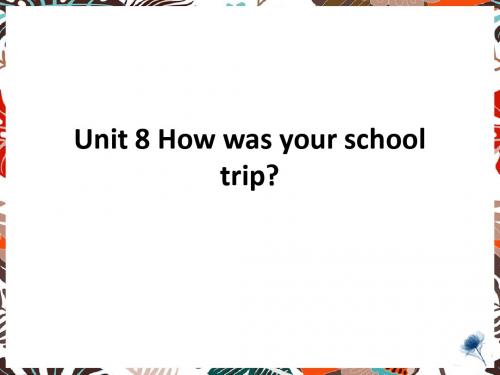
• (7)用作介词,表示事情发生的时间,用 在具体某一天前面。
• on a cold Sunday morning 周日上午
在一个寒冷的
• on May, 12th
在5月12日
• (8)用作介词,意为“关于;谈及”,含有 学术性。
• an essay on political economy 一篇政治经 济学方面的文章
• You must show your ticket at the barrier. 你必 须在检票处出示门票。
• 搭配: show sb. sth. = show sth.to sb. 把某 物给某人看
• Could you show me your photos? = Could you show your photos to me?
talk over 谈论 have a talk
have ice
go to the
• hang out with one’s friends 和朋友闲逛 buy a souvenir 买纪念品
• take photos=take a photo=take pictures=take a picture 照相
直工作,不休息。
• (2)用作副词,表示穿上、戴上(衣服、 鞋帽等)。
• Put your coat on. 穿上你的大衣。
• (3)用作副词,指(电器或电源)在接通或 使用中。
• The TV is always on in their house. 他们家电视 老是开着。
• (4)用作副词,指“(演出节目、戏剧等)在 进行中”。
• at the end of January 在1月底(表示时间)
• at the end of the street 在街道末端(表示 地点)
八年级英语上册第八单元

八年级英语上册第八单元知识点
1.重点短语:be ready to do sth. 乐于做某事
2.重点句型:
How can we become good learners? 怎样成为优秀的学习者?
We can start by asking the teacher for help when we have problems. 当我们有问题的时候,我们可以向老师寻求帮助。
We can also work in groups to discuss the questions. 我们也可以分组讨论问题。
3.语法重点:现在进行时态(The Present Continuous Tense)构成:be + V-ing (动词的现在分词)
用法:表示正在进行的动作或存在的状态。
4.写作练习:写一篇题为“How to Become a Good Learner”的短文,介绍如何成为优秀的学习者。
5.词汇与表达:重点单词和短语,如“prepare”、“finish”、“decide”、“doubt”、“compare”、“impress”、“challenge”、“wisely”、“attitude”、“opportunity”、“improve”等。
6.阅读理解:阅读一篇关于学习方法的文章,理解并回答相关问题。
7.听力练习:听一段关于学习方法的对话,完成听力练习。
8.课堂活动:组织学生进行小组讨论,分享自己的学习方法和心得体会,互相学习、互相帮助,共同提高学习效果。
人教版八年级上册英语Unit8知识点梳理及语法讲义(教师版)

八年级上册英语Unit 8知识点与语法精讲精练词汇梳理(一)完成单词梳理:名词:1. blender食物搅拌器 2. yogurt 酸奶 3. honey 蜂蜜4. watermelon 西瓜5. spoon 勺;调羹6. pot 锅7. salt 食盐8. sugar 食糖9. cheese 干酪;奶酪10. popcorn 爆米花11. corn 玉米;谷物12. machine 机器;机械装置13. hole 洞;孔;坑14. lettuce 莴苣;生菜15. sandwich 三明治16. butter 黄油;奶油17. turkey 火鸡18. piece 片;块;段19. Thanksgiving 感恩节20. autumn 秋天;秋季21. gravy (调味)肉汁22. pumpkin 南瓜23. pie 果馅饼;果馅派24. pepper 胡椒粉;柿子椒25. oven 烤箱;烤炉26. plate 盘子;碟子27. temperature 温度;气温;体温动词:1. peel 剥皮;去皮 2. pour 倒出;倾倒 3. add 增加;添加4. dig 掘(地);凿(洞)5. celebrate 庆祝;庆贺6. prepare 使做好准备;把……准备好7. fill (使)充满;填满8. serve 接待;服务;提供副词:1. finally 最后;最终形容词:1. traditional 传统的;惯例的 2. mashed 捣烂的兼类词:1. shake (v/n)摇动;抖动 2. mix (n)混合配料(v)(使)混合;融合3. cover (v)遮盖;覆盖(n)覆盖物;盖子;封面(二) 词汇变形小结:1. shake (v. 摇动) — shook (过去式)2. final (adj. 最后的;最终的) — finally (adv. 最后;最终)3. dig (v. 掘地) — dug (过去式) — digging (现在分词)4. tradition (n. 传统) — traditional (adj. 传统的;惯例的) — traditionally (adv.传统地;惯例地)5. celebrate (v. 庆祝;庆贺) — celebration (n. 庆典;庆祝活动)6. prepare (v. 使做好准备) — preparation (n. 准备;准备工作)【练一练】用所给词的适当形式填空1.My father __finally___(final) agreed to let me go on the trip.2.I __shook____(shake) the medicine bottle before I took the medicine.3.Jack ate three __tomatoes___ (tomato) for breakfast this morning.4.The boys ___dug_____ (dig) twenty holes for the trees last Sunday.5.The Spring Festival is a __traditional___ (tradition) festival in China..6.Some friends of mine like to eat __sandwiches___ (sandwich) with onions.7.My brother often ___mixes____(mix) his Chinese books and English books.8.Why not ___serve____ (serve) the soup to your friend, Kate?9.My sister helped me ___to pour___ (pour) the water into the cup.10.Could you please tell me how ___to make___ an apple shake? (make)(三) 短语攻关:milk shake 奶昔turn on 接通(电流、煤气、水等);打开cut up 切碎pour...into...把……倒进……里good idea好主意put...into... 把……放进……里a piece of 一片;一块;一段mix up 混合cover...with...用……覆盖fill...with... 用……把……装满one by one 逐个;逐一traditional food 传统食物at a very high temperature以高温at this time 在这时give thanks for sth 因某事/物而感谢give thanks to sb对某人表示感谢1. Turn on the blender. 打开食物搅拌器。
Unit 8 知识点总结归纳【人教版八年级上册英语】

Unit 8 How do you make a banana shake?Section A1a-2d1.Turn on the blender.turn on意为“打开”,反义词是turn off,意为“关掉”。
(电源开关)e.g:Please turn on the radio.Don’t forget to turn off the light.turn down (把音量)调小,调低turn up (把音量)调大,调高“开(关)门、窗、盒子”等用动词open和close。
e.g:It’s too dark..Please turn on the light.太黑了,请开灯吧。
2.Peel the bananas.peel “剥,削(水果的皮)”,为及物动词,其后既可接名词、代词作宾语,也可接双宾语,即peel sb. sth. 或peel sth. for sb.,意为“给某人削(剥)果皮”。
3.Cut up the bananas.cut up意为“切碎”,其中up为副词。
E.g:cut up the apple 把苹果切碎cut it(them) up 把它(它们)切碎4.Pour the milk into the blender.pour...into...表示“将……倒进……里面”,pour...out表示“把……倒出来”。
e.g:Please pour the water into the bowl.Please pour the milk out.5.How do you make a banana milk shake?make用作实义动词,表示“制作、做”,make sb. sth.相当于make sth. for sb.“为某人制造某物”。
e.g:My mother often makes some fresh juice for us.6.Next, put the beef, carrots and potatoes into a pot and add some water.(1) put...into...表示“把……放进……里面去”,e.g:He put that book into the box.(2)add用作及物动词,表示“增加、添加”,add...to...“把……添加到……上去”。
八年级上册英语unit8知识点总结

八年级上册英语unit8知识点总结在这一单元里,我们学习了许多生活常用词汇和交流用语。
本文将对这些知识点进行总结。
一、复习单词本单元所涉及的词语主要有:breakfast, sandwich, salad, soup, chicken, shrimp, beef, pork, vegetable, tomato, onion, cucumber, mushroom, pepper, carrot, fry, boil, bake, grill, roast, stir-fry, ingredient, recipe, teaspoon, tablespoon, cup, bowl, plate, knife, fork, spoon, chopsticks, serve, order, waiter/waitress, menu 等。
二、学习语法1. 不定代词本单元中,我们学习了不定代词some,any,no和every的用法。
在肯定句中,some表示“一些”,any表示“任何”,no表示“没有任何”,every表示“每个”。
在疑问句和否定句中,some变成了any,every也变成了no。
如:Would you like some soup? 你想来点汤吗?There isn’t any beef in the refrigerator. 冰箱里没有牛肉。
2. 可数名词和不可数名词在本单元中,我们还学习了可数名词和不可数名词的用法。
可数名词有单数形式和复数形式,而不可数名词只有单数形式。
如:I have two eggs for breakfast. 我今天早餐吃了两个鸡蛋。
I’d like some tea. 我想要些茶。
3. 情态动词情态动词在英语中用来表达说话人的意愿、能力、推测等情态。
在本单元中,我们学习了can和should的用法。
can表示能力,“能”,should表示建议,“应该”。
八年级英语上册Unit8知识点归纳

8AUnit8同步知识点讲解及练习【知识梳理】1.Didn't you hear the rain? 难道你没听到雨声吗?是否定疑问句,意为“难道.......不/没有…吗?否定疑问句的回答形式同肯定疑问句,且一定要根据事实回答,事实是肯定的就用yes,反之就用no。
Eg: 1.---Don't you like English?---_______________. I like it very much.2. ---Can't you swim?---________________. I will learn to swim this year.Keys:Yes, I do.; No, I can’t.2.wake up 醒来如果人称代词作宾语,人称代词要放在wake与up之间;若名词作宾语,名词可放于wake 与up之间,也可放于up之后。
3.Who will mop up the water if I go home without you?mop (mopped, mopped, mopping)mop up 擦干,抹去如果其宾语是人称代词,人称代词要放在mop与up之间。
例如:mop up the floor 把地拖干净mop it up把它擦干净up adv.,此处意为“完全地,彻底地”,用在某些动词之后,表示完结、用完、清除干净。
use up用光,用尽 eat up吃光4.lose final 输掉决赛lose v.丢失;(过去式:lost)lost adj.丢失的final. n. 决赛adj. 最后的lose one’s life 丢了性命;be lost= get lost 迷路的lose the match 输了比赛;Eg:每年,数百万人在自然灾害中丧生。
Every year, millions of people_____________________________________________________. Keys:lose lives in natural disasters5.thousands of意为“成千上万”,后接复数名词thousand 前有数字,不加s,不加of; 没有数字,要加s,加ofhundred, million, billion用法和thousand一样Eg:1.There are over three__________workers in this factory, and_________of young people want to work in it.A.thousand;thousandB.thousands;thousandsC.thousand;thousandsD.thousands;thousand2.______students went to the university to listen to the_____ speech.A.Thousand of;120-minutesB.Thousands of;120-minutesC. Two thousands: 120- minutesD. Two thousand; 120-minuteKeys:C;D6.wash away 冲走如果人称代词作宾语,人称代词要放在wash与away之间;若名词作宾语,名词可放于wash 与away之间,也可放于away之后。
人教版八年级上册英语Unit 8 知识点语法归纳总结

人教版八年级上册英语Unit 8 知识点语法归纳总结一、过去进行时(Past Continuous Tense)过去进行时用于表示过去某一时刻或某段时间正在进行的动作或状态。
1. 构成肯定句:主语 + was/were + 动词的ing形式否定句:主语 + was/were not + 动词的ing形式一般疑问句:Was/Were + 主语 + 动词的ing形式?肯定回答:Yes, 主语 + was/were.否定回答:No, 主语 + wasn't/weren't.2. 使用场景过去进行时常用于以下场景:- 表示过去某一时刻正在进行的动作- She was cooking dinner when I arrived. (我到达的时候,她正在做晚饭。
)- 表示过去某一段时间内持续进行的动作- They were playing basketball all afternoon. (他们整个下午都在打篮球。
)- 表示过去两个同时进行的动作- While he was studying, I was watching TV. (他在研究的时候,我正在看电视。
)二、过去完成时(Past Perfect Tense)过去完成时用于表示在过去某一时间或动作之前已经发生的动作或状态。
1. 构成肯定句:主语 + had + 过去分词否定句:主语 + hadn't + 过去分词一般疑问句:Had + 主语 + 过去分词?肯定回答:Yes, 主语 + had.否定回答:No, 主语 + hadn't.2. 使用场景过去完成时常用于以下场景:- 表示在过去某一时间或动作之前已经发生的动作- They had already left when I arrived. (当我到达时,他们已经离开了。
)- 表示过去某一时间之前已经完成的动作- She had finished her homework before dinner. (她在晚饭之前已经完成了作业。
八年级上册英语unit8知识点

Unit 8 How do you make a banana milk shake一、重点单词n名词:奶昔果汁机酸奶蜂蜜勺子,汤匙,调羹盐胡椒粉,辣椒糖黄油干酪,奶酪玉米,谷物爆米花三明治面包片,块,件,篇生菜,莴苣火鸡肉汁,肉汤西瓜盘子,碟子烤箱,烤炉n.盖子,覆盖物v.遮盖,盖上用下划线标出以上单词中的不可数名词v动词:切,割切碎倾倒,灌倾倒进…剥皮,剥落加,增加把…加到…服务,提供混合把…和…混合在一起adj形容词:传统的prep介词:into到……里,add…into…pour…into… put…into…adv副词:finally最后地,最终(first, next, then, finally)=at last=in the end二、重点短语1. 打开、接通2.关掉(电器)调高(音量)调低(音量)3. 把…倒入4.一片,一张,一条,一块,一首5. 多少6.两勺7.水果沙拉 8罗宋汤 9烹饪十分钟10.再烹饪十分钟 11.另一件事 12.忘记做某事13.爆米花机 14.植树 15.挖一个洞 16.从图书馆中带一本书出来 17.吃传统的食物 18.在特殊的节日里19混合在一起 20用…把…装满21.用…覆盖/盖着…11.制作香蕉奶昔12.火鸡切片13.这儿是制作…的食谱14.在这时15.一杯酸奶16.需要一些帮助18.把…放在…的上面19.一个接一个20. 一些生菜三、重点语法1. 可数名词与不可数名词可数名词,单数形式在前面加a\an;不可数名词前面不加a, an,不能用基数词连用,但可以用a little, much, some, a lot of, lots of, enough, most等修饰。
需要计量时,可以在前面加计量词组=数词\冠词+量词+of +不可数名词:a spoon of tea a cup of yogurt a bottle of a piece of a bag of注意:既可修饰可数名词与不可数名词的词有:a lot of =lots of , some, any(用在疑问句或者否定句)可数名词量的提问:How many+可数名词复数+ do we need?不可数名词量的提问:How much+不可数名词+do we need?2.need的用法:①. need作实义动词,意为“需要”,need+名词/代词,eg:Human need air. /We need 2 spoons of honey.need to do sth. 需要做某事,Do you need to stay at home? 你要呆在家里吗?②. need作情态动词,一般只用于对must的否定回答,不用于肯定句。
八年级上册英语unit 8知识点
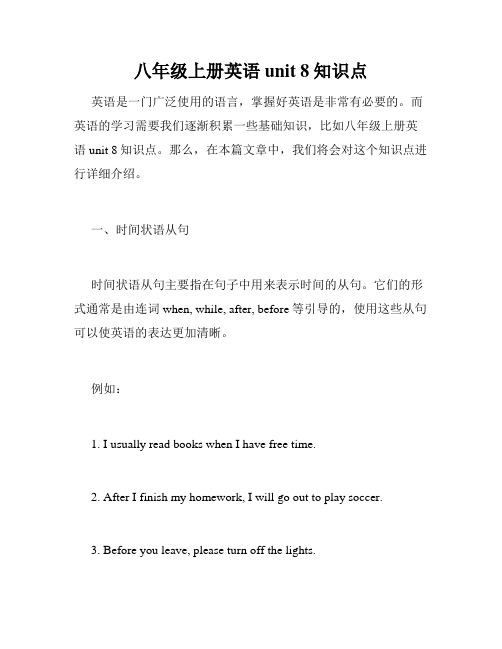
八年级上册英语unit 8知识点英语是一门广泛使用的语言,掌握好英语是非常有必要的。
而英语的学习需要我们逐渐积累一些基础知识,比如八年级上册英语unit 8知识点。
那么,在本篇文章中,我们将会对这个知识点进行详细介绍。
一、时间状语从句时间状语从句主要指在句子中用来表示时间的从句。
它们的形式通常是由连词when, while, after, before等引导的,使用这些从句可以使英语的表达更加清晰。
例如:1. I usually read books when I have free time.2. After I finish my homework, I will go out to play soccer.3. Before you leave, please turn off the lights.二、虚拟语气虚拟语气指表示假设、虚构情况或者与现实相反的语气。
在学习英语时,虚拟语气是一个比较难懂的知识点。
它通常用于宾语从句、表语从句、条件状语从句中,形式可以是过去式、should/would/could+动词原形等。
例如:1. If I were you, I would go to see the doctor.2. It is necessary that he should be here on time.3. I wish I could speak English fluently.三、被动语态被动语态是英语中一个非常重要的语法知识点。
在英语中,被动语态通常用于强调或不知道行为的执行者,而主动语态则强调行动的执行者,形式通常是“be+过去分词”。
例如:1. The book was written by him.2. The window was broken by the little boy.四、情态动词情态动词是表示说话人的心理状态、想法或说话人与读者之间的关系的词汇,如can, may, should, must, will等。
八年级上英语unit8知识点

八年级上英语unit8知识点英语是一门必修科目,对于初中生来说,八年级上英语unit8是一个重要的学习阶段。
在这个单元中,学生需要掌握一些重要的知识点。
本文将详细介绍八年级上英语unit8的所有知识点,以帮助学生更好地理解和掌握课程内容。
一、名词性从句名词性从句是指在句中充当名词成分的从句。
名词性从句包括主语从句、宾语从句、表语从句和同位语从句。
名词性从句的引导词有:that、who、which、where、when、why、如果、whether 等。
例句:1. What he said is true. (主语从句)2. I don't know where my pen is. (宾语从句)3. The fact is that she is ill. (表语从句)4. The news that he passed the exam surprised me. (同位语从句)二、情态动词情态动词是指能够表示说话人态度和语气的动词,包括:can、could、may、might、must、shall、should、will、would等。
情态动词后面一般跟动词原形,用于表示能力、推测、义务等。
例句:1. You must finish your homework before you go out.2. He can speak Chinese fluently.3. We should take care of the environment.三、虚拟语气虚拟语气是指在实际情况下不可能实现的情况下使用的语气,包括:虚拟条件句、虚拟语气与情态动词等。
虚拟语气常用于表达猜测、愿望和建议等。
例句:1. If I were you, I would choose science instead of art.2. I wish I could travel around the world.3. He suggested that we should plant more trees.四、长难句分析长难句是指句子结构复杂,难于理解和掌握的句子。
八年级英语上册Unit 8知识点解析及短语归纳
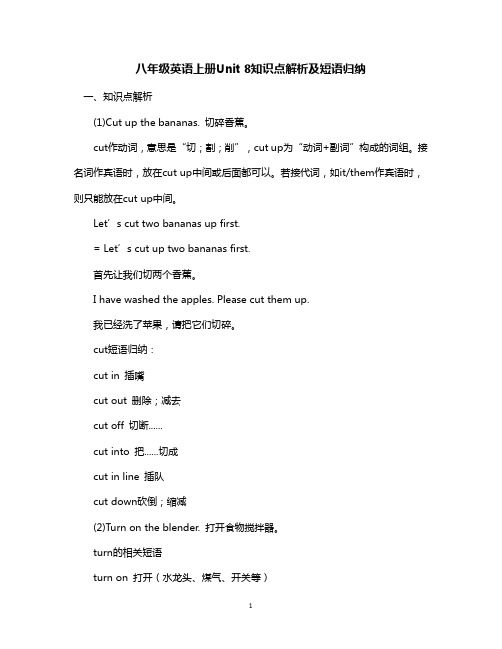
八年级英语上册Unit 8知识点解析及短语归纳一、知识点解析(1)Cut up the bananas. 切碎香蕉。
cut作动词,意思是“切;割;削”,cut up为“动词+副词”构成的词组。
接名词作宾语时,放在cut up中间或后面都可以。
若接代词,如it/them作宾语时,则只能放在cut up中间。
Let’s cut two bananas up first.= Let’s cut up two bananas first.首先让我们切两个香蕉。
I have washed the apples. Please cut them up.我已经洗了苹果,请把它们切碎。
cut短语归纳:cut in 插嘴cut out 删除;减去cut off 切断......cut into 把......切成cut in line 插队cut down砍倒;缩减(2)Turn on the blender. 打开食物搅拌器。
turn的相关短语turn on 打开(水龙头、煤气、开关等)Please turn on the light.请打开灯。
turn off 关掉;关上(电器、开关等)You should turn off the light.你应该关灯。
turn down 关小;调低(收音机、电视等的音量)The TV is too loud. Please turn it down.电视声音太大了,请关小点。
turn up 调大(电视、收音机等的音量)He turned up the radio.他把收音机的声音开大了。
二、必背句型①No, one more thing.不,还有一件事。
②Finally, don’t forget to add some salt.最后,不要忘了加些盐。
③How do you make a banana milk shake?你是怎样制作香蕉奶昔的?④These days, most Americans still celebrate this idea of giving thanks by having a big meal at home with their family.这些天来,大多数美国人仍然通过在家里和家人吃一顿大餐的方式,庆祝这种感恩的思想。
最新人教版八年级上册英语-unit8详细知识点
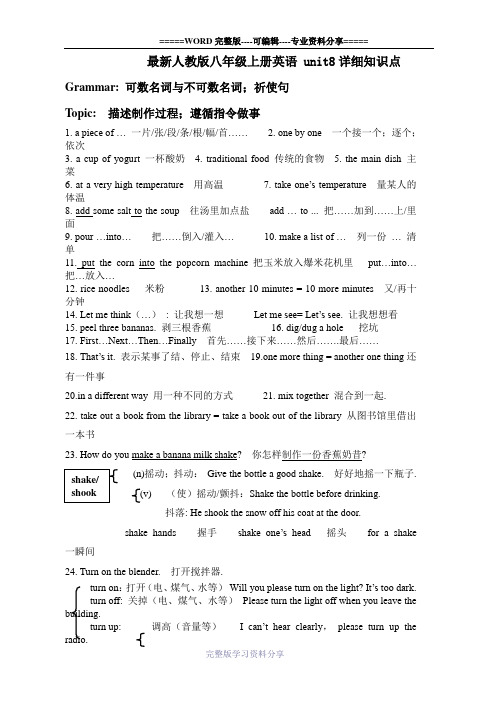
最新人教版八年级上册英语 unit8详细知识点Grammar: 可数名词与不可数名词;祈使句Topic: 描述制作过程;遵循指令做事1. a piece of … 一片/张/段/条/根/幅/首……2. one by one 一个接一个;逐个;依次3. a cup of yogurt 一杯酸奶4. traditional food 传统的食物5. the main dish 主菜6. at a very high temperature 用高温7. ta ke one’s temperature 量某人的体温8. add some salt to the soup 往汤里加点盐add … to ... 把……加到……上/里面9. pour …into… 把……倒入/灌入… 10. make a list of … 列一份… 清单11. put the corn into the popcorn machine 把玉米放入爆米花机里put…into…把…放入…12. rice noodles 米粉13. another 10 minutes = 10 more minutes 又/再十分钟14. Let me think(…): 让我想一想Let me see= Let’s see. 让我想想看15. peel three bananas. 剥三根香蕉16. dig/dug a hole 挖坑17. First…Next…Then…Finally 首先……接下来……然后…….最后……18. That’s it. 表示某事了结、停止、结束19.one more thing = another one thing还有一件事20.in a different way 用一种不同的方式21. mix together 混合到一起.22. take out a book from the library = take a book out of the library 从图书馆里借出一本书23. How do you make a banana milk shake? 你怎样制作一份香蕉奶昔?(n)摇动;抖动:Give the bottle a good shake. 好好地摇一下瓶子.(v) (使)摇动/颤抖:Shake the bottle before drinking.抖落: He shook the snow off his coat at the door.shake hands 握手shake one’s head 摇头for a shake 一瞬间24. Turn on the blender. 打开搅拌器.turn on:打开(电、煤气、水等)Will you please turn on the light? It’s too dark.turn off: 关掉(电、煤气、水等)Please turn the light off when you leave the building.turn up: 调高(音量等)I can’t hear clearly,please turn up the radio.出现If he doesn’t turn up in ten minutes,we’ll have to go.turn down: 调低(音量等):Please turn down the TV when I’m talking onthe phone.拒绝She turned down his invitation.25. cut up the bananas. 把香蕉切碎.cut:(n)切口;伤口;(v) 切,割,剪,砍,削等cut… into… :把…切成… cut the turkey into pieces.cut off:切断;中断He almost cut off his finger while working.cut up 切碎;剁碎cut the onion up in small pieces.伤害;折磨:He was cut up badly when he fell off his bike.cut down:砍倒;削减They cut down the old trees in order to build a new factory.22.A: How much yogurt do we need? B: We need one cup of yogurt.1). how many: 多少+ 可数名词:how many watermelons do you need?how much 多少+ 不可数名词:How much cheese/sugar do we need?多少钱= What’d the price of…? How much is the butter? 2). (n) : There’s no need for you to hurry. 你没有必要慌张.Sb. need sth. She needs help.实) Sb. need to do sth. You need to get it back tomorrow.需要;Sth. need doing = sth. need to be done. The bike needs repairing.必须(v情: ) 用于否定和疑问: You needn’t tell me. 你没有必要告诉我.Need I go there? Yes,you must./have to. No,you needn’t.in need of…: 需要… at need: 在紧急时23.Next,fill the turkey with this bread mix. 接下来,把这个面包混合物填充到火鸡里.使充满;装满: fill A with B = A be filled with B = A be full of B1). Fill the bottle with water. = The bottle is filled with / is full of water.占据,胜任(职位;工作) : She is the best person to fill this kind of job.(n)混合物(=mixture);食品混合干配料 a cake mix使掺和;使混合:She mixes the flour and milk together.2). mix…with…: 把…与…调在一起 He mixed red paint with yellow paint.(v ) mix… into…: 把…掺在…里面 She mixed some salt into the soup.调制: mix salad 拌色拉24. When it is ready , place the turkey on a large plate and cover it with gravy.(n) 盖子;封面;罩: The book has a blue cover.覆盖;遮盖: cover … with… = …be covered with…(v) She covered the table with a cloth. = The table was coveredwith a cloth.掩饰;隐瞒 Jim tried to cover his mistake with a joke.25. Finally , serve it to your friends with some vegetables. 最后,与其它食物一起端出来供朋友使用.为…服务/工作/效力: serve people. 接待;服侍(顾客):Are you being served? 你点过菜了吗?/有人接待你吗?端出(食物);伺候…进餐:serve the fish to the guests.26. Now , it’s time to enjoy the rice noodles! 现在,到了享用米粉的时候了.for sth. : It’s time for supper. to do sth. It ’s time to have supperfor sb. to do sth. It’s time for you to get up.可数名词与不可数名词1. 可数名词 ----可数名词指物体的数量可数.其单数形式可在名词前加a 或an ,表示“一个”,如:a banana.其复数形式要在词尾加s 或es (特殊情况除外),如:two bananas.名词复数的不规则变化:man-men woman-women policeman (男警察)-policemen policewoman (女警察)-policewomen mouse-mice child-children foot-feet tooth-teeth fish-fish sheep-sheep deer -deer people-people Chinese-ChineseJapanese-Japanese1)以f(e)结尾的名词变复数leaf→leaves half→halves wife→wives knife→knives shelf→shelves wolf→wolves thief→thieves2)以o结尾的: hero,Negro,tomato,potato + es; 其他的都加s:radio,zoo.表示“某国人”的名词变复数中日不变英法变,其他-s加后面. Chinese,Japanese,Englishman,Frenchman,American,Australian,German2. 不可数名词 -------不可数名词指物体的数量不可数.不可数名词没有单复数之分,也不能在词前直接加冠词a或an.表示不可数名词的数量时可在不可数名词前加相应的数量词构成短语. 如:a piece of…, a glass of…, a bottle of…., a bag of…, a teaspoon of…等.二.1.既可修饰可数名词也可修饰:all,some,most,a lot of,lots of,plenty of …2.修饰可数名词的词有:数词(one...),few,a few,many,a number of,numbers of...3. 修饰不可数名词的词有:little,a little,a bit of,much,a great deal of,a large amount of4. 不可数名词通常用“数词+量词+of+不可数名词”表示复数:three pieces of paper祈使句一.定义:祈使句指的是表示命令、请求、建议或劝告的句子.其主语you常省略,谓语动词用原形,句末用感叹号或句号,读降调.二.结构:1. 肯定的祈使句:动词原形+其他Stand up,please. Be careful!2.否定的祈使句: 1). Don't + 动词原形Don’t laugh at others.2). Never do sth. Never do that again!3). No + v-ing/n. No smoking! No noise,please.4). Let’s not do sth. Let’s not waste time.5). Don’t let sb. do sth. Don’t let them make any noise.Unit 8 How do you make a banana milk shake?一、词汇积累1. milk shake 奶昔shake v. & n. 摇动,抖动shake hands with sb./ shake one’s hands 与某人握手2. turn on 打开反义词:turn off 关上turn up 调大,开大音量反义词:turn down 调低音量易错点:遇到动词加副词,要符合以下原则:动词加副词,名词两边放,代词放中间.e.g. turn on the radio = turn the radio on,但是turn it on 不能说turn on it3. cut up 切碎过去式:cut,过去分词:cutcut up = cut into pieces 切成碎片cut into halves 切成两半4. make v. 制作,做make sth. For sb. = make sb. sth. 为某人做某物与make 的一些搭配:make friends 交朋友make a mistake/ mistakes 犯错误make tea 沏茶v. 使役动词“使”make sb. do sth. 使某人做某事make sb./ sth. + adj. 使某人/ 某物……5. need v. & n. 需要v. need sth. 需要某物need to do sth. 需要做某事n. He can’t meet all your need.作情态动词“需要”,后面用动词原形,常用于否定和疑问句中:e.g. You needn’t finish your work now.---Need I go there with him?---Yes,you must./ No,you needn’t.6. another adj. & pron. 另一,再一e.g. Can I have another cake? (another 作形容词)Give me another. (another 作代词)注意:another 与one more 意思相同,表示另外几个时,another 后面接相应的数词,而one more 中的“one”也改为相应的数词.e.g. I want to buy another three pencils. = I want to buy three more pencils.7. forget v. 忘记反义词:remember 记得forget sth./ sb. 忘记某事/ 某人forget to do sth. 忘记去做某事(事情未做)forget doing sth.忘记做过某事(事情已做)常会遇到一个词“leave”,也可表“遗忘”leave sth. at/ in/ on + 某地把某物忘记在……8. like v. & n. & prep.喜欢;喜好;像v. like sth./ sb.like to do sth./ like doing sth. 喜欢做某事n. likes and dislikes 喜好反义词:dislikeprep. 像反义词:unlike9. traditional adj. 传统的traditional n. + al adj.10. a time to………的时间It’s time to do sth. 到了该做……的时候了It’s time for sth./ doing sth.11. give thanks for…为……表达谢意Thanks for doing sth. = Thanks for sth.12. remember v. 记得,记起,回想起remember sth./ sb. 记得某事/ 某人remember to do sth.记得去做某事(事情未做)remember doing sth.记得做过某事(事情已做)remember me to sb. 代我问候某人13. traveler = traveller 漂泊者,旅行者,游客= tourist 旅游者,观光者14. celebrate v. 庆祝,庆贺celebrate one’s birthday/ 节日/ 胜利celebration n. 庆祝15. mix … with…把A 和B混在一起be mixed with… (被动语态)16. fill… with…用……填充……be filled with = be full ofbe filled with…(被动语态)A is filled withB A被B填满(动作) A is full of B A充满着B (状态)17. cover… with…用……遮盖cover sth. with sth. be covered with 被某物覆盖(被动语态)18. serve v. 服务,提供serve sb. sth. = serve sth. to sb. 提供某人某物serve sb. 为某人工作serve service(n.) servant(佣人)19. temperature n. 温度,气温,体温(既可作可数名词,又可作不可数名词)get/ have a temperature = get/ have a fever 发烧take one’s temperature 试体温,量体温20. the reason for…是……的原因(理由)the reason to do 有理由干某事21. to make this special food 不定式做目的状语e.g. The doctor did what he could to save the injured girl. (表目的)to do 还可在句中作后置定语 e.g. I have a lot of work to do.Unit 8 How do you make a banana milk shake?本单元的话题:描述做事情的顺序和过程.(First首先,Next下面,Then然后,Finall y最后)本单元的语法:复习一般现在时.本单元的短语和知识点:1(P57,1a) turn on打开turn up调大turn off关上turn down调小Please turn on the lights.请打开灯.My father is sleeping,please turn down the radio.爸爸正在睡觉,请把收音机声音调小.2. (P58,2a) How many+可数名词复数:多少…How much+不可数名词:多少…He has eight books.他有八本书.→How many books does he have?他有多少本书?How much water does he need?他需要多少水?3. (P58,2a) 量词的用法:不可数名词常用“数字+量词+不可数名词”来表示.如:a piece of bread一片面包比较:two piece s of bread两片面包(bread为不可数名词)a glass of orange 一玻璃杯橘子汁one spoon of butter 一勺黄油4.(P58,2d)说明做某事的顺序为:First…首先,Next…下面,Then…然后,Finally…最后5.(P58,2d末行)one more thing = another one thing基数词+ more + 名词= another + 基数词+ 名词:又多少某物He ate an apple,he wanted to eat two more apples.他吃了一个苹果,还想再吃两个. 6.(P59,3c)Do you know how to plant trees?你知道如何种树吗?how to do sth.怎样做某事(疑问词后跟动词须加to,即“疑问词to do sth”)He doesn’.他不知道如何打开电脑.7.(P61,2b,4行)It’s time (for sb) to do sth是某人该做某事的时间了.It’s time for us to have lunch.是我们该吃午饭的时候了.It’s time for sth是该做某事的时间了.It’s time for the class.是该上课的时候了.8.(P61,2b,1段倒数3行)by doing sth:通过…方式He learned English by listening to the radio.它通过听收音机学习英语.9.(P61,2b,2段)fill…with…用…装满,cover…with… 用…盖住10.(P63,3a,3行)need to do sth:需要做某事He needs to buy a new pen.他需要买一枝新钢笔.。
Unit8重要知识点知识点牛津译林版英语八年级上册

8A U8【wele】1.I was sleeping when it started to rain.when引导的时间状语从句,was sleeping是过去进行时。
过去进行时构成:was/were+ving,表示过去某个时间正在进行的动作。
2.Didn’t you hear the rain?否定疑问句,表示一种惊讶或反问、失望、责难等语气。
都定疑问句应翻译为“难道....不吗?”否定疑问句用法1)表示说话人语预期或希望得到肯定答复。
Haven’t you finished yet?你还没有结束吗?2)表示赞叹或感慨,意为“真是....”,译成汉语是,句末用感叹号。
Isn’t it a fine day today?今天的天气多么晴朗啊!3)表示批评、厌烦、责难等。
Can’t you walk a little faster?难道你不能走快点吗?4)表示教客气地提出请求、邀请等。
Won’t you e and have dinner with us?难道你不想和我们一起吃晚饭吗?3.mop up用拖把完全擦干净(名随代中)eat up吃光use up用光end up结束pay up付清4.具体数字+hundred/thousand/millionhundreds/thousands/millions of...5.coach n.长途汽车n.教练;私人教师vt.训练,指导6.crash vi.“碰撞,撞击”crash into 撞上7.wash away冲走(名随代中)8.start vt.引起vi.出发;开始9.hear about/of 听说表示间接听说关于某人或某事的情况hear 听见表示亲耳听见某事或某人说话hear from 收到...来信+sb表示“收到某人的来信”10.hit vt.袭击;危害hithittinghit11.catch a fire着火= sth be on fire【reading】vt.“摇动,震动”shake hands with sb与某人握手shake one’s head摇头3.loud adj.响亮的;大声的;喧闹的loudloudly4.in fear处于恐惧状态5.try/do one’s best to do sth尽某人最大的努力做某事6.run out跑出来;(时间、食品、金钱等无生命名词)用完run out of 从...跑出来;把...用完7.in all direction = in every direction 四面八方8.fall down ①“掉落;下落”②“跌倒,倒下”后面接宾语时要加介词fromfall over “跌倒”,一般指向前摔倒,其后不加宾语fall off “跌落,从...掉下来”,后面可以直接加宾语9. e down ①崩塌,坍塌②(价格)下降10.not...at all “一点也不,根本不”,at all放在句尾用于加强否定的语气。
- 1、下载文档前请自行甄别文档内容的完整性,平台不提供额外的编辑、内容补充、找答案等附加服务。
- 2、"仅部分预览"的文档,不可在线预览部分如存在完整性等问题,可反馈申请退款(可完整预览的文档不适用该条件!)。
- 3、如文档侵犯您的权益,请联系客服反馈,我们会尽快为您处理(人工客服工作时间:9:00-18:30)。
Unit8 How do you make a banana milk shake? 一·重点单词用法1. shake v. 摇动;抖动过去式:shook 现在分词:shaking n. 奶昔milk shake 奶昔make a banana milk shake做香蕉奶昔2.pour v.倒出;倾倒pour…into… 把…倒进…里eg. Please pour the water into the bowl.pour sth for sb 给某人倒某物3. honey n.蜂蜜(不可数)4. add v.增加;添加add…to… 给…加上…eg.Will you add more sugar to the coffee?5.finally adv.最后;终于同义短语:at last,in the endeg. Finally ,they got home at ten o’clock. 6. salt n.食盐(不可数)sugar n.糖(不可数)cheese n.干酪;奶酪(不可数)7. dig v.掘(地);凿(洞);挖(土)hole n.洞;孔;坑(可数)dig a hole 挖一个坑过去式:dug 现在分词:diggingWhat are you digging? 你正在挖什么?8. sandwich n.夹心面包片;三明治复数:sandwichesbutter n.黄油;奶油(不可数)9.piece n.片;块;段复数:piecesa piece of 一片;一块;一条;一首;一张有多种含义。
后接不可数名词,表示数量;如果表示的数量超过一个,则piece用复数形式。
a piece of短语作主语时,谓语动词用单数形式;而…piece of作主语时,谓语动词用复数形式。
eg. There is a piece of bread on the plate.There are two pieces of bread on the plate.10. traditional adj.传统的;惯例的tradition n.传统eg.I think many people like this traditional art.11.autumn n.秋天;秋季相当于fallin autumn 在秋天;在秋季spring 春天summer 夏天autumn 秋天winter 冬天12.traveler n.漂泊者;旅行者;游客travel v.旅行;游历复数:travelers13. celebrate v.庆祝;庆贺; celebration n.庆祝(活动);eg. How do you usually celebrate New Year?14. mix n. 混合配料;v. (使)混合;融合mix… and… 把……和……混合eg. You can’t mix oil and water.mix up 混合;混淆eg. Let’s mix up the two kinds of seeds. 15. fill v.(使)充满;装满fill…with… 用……装满……eg. The boy fill the bottle with sand.那个男孩用沙子把瓶子装满了。
be filled with 充满……装满……同义短语:be full ofeg.The large box is filled with books.The bag was full of clothes.16. cover v. 遮盖;覆盖;n.覆盖物;盖子cover…with… 用……覆盖……be covered with 被……覆盖eg.Ann covered her face with her hands.安用双手捂住脸。
cover 作名词,意为“封面;覆盖物;盖子”17. serve V. 接待;服务;提供serve sth. to sb.=serve sb. (with) sth.用某物招待某人。
eg.The waiter serves a glass of beer to him.=The waiter serves him (with) a glass of beer.18. temperature n.温度;气温;体温(不可数)take one’s temperature 量体温课文重点:1.t urn on 打开;接通(电流、煤气、水等)宾语是人称代词时,要放在turn和on之间turn on 打开;接通(电流、煤气、水等)turn off 关闭;切断(电流、煤气、水等)turn up 调高(音量等)turn down 调低(音量等)2.cut up切碎(人称代词作宾语放在两词中间)=cut…into pieceseg.Hand the meat to me. I’ll cut it up.put up 张贴;搭建;举起use up用尽wake up醒来stay up熬夜dress up装扮;乔装打扮take up占据;开始从事3.peel v.剥皮;去皮4.make v.做;制作make a decision做决定make a mistake 犯错误make a living谋生make sure确保5.need v.需要,做实义动词:need sth需要……need to do sth需要做……eg.She needs to have a try. 她需要试一下。
need做情态动词,后跟动词原形,一般用于否定句或疑问句eg.You need n’t go this week.你这周不必去。
由must引导的一般疑问句,肯定回答用must,否定回答用needn’t或don’t/doesn’t have to(不必)eg.--Must I go now?我现在必须走吗?--Yes,you must./No,you needn’t/don’t have to.6. how much“多少”,提问数量,后接不可数名词eg.How much water do you want?你想要多少水?“多少钱”,提问价格eg.How much are your shoes?你的鞋子多少钱?how many“多少”,提问数量,后接可数名词复数eg.How many books do you have?你有几本书?7.put…into…把……放进……eg.He put that book into the box.8. “another+基数词+名词”,表示“又/再/另……”=“基数词+more+名词”eg.May I have another two bananas?= May I have two more bananas?Do you know how to plant a tree?9.how to plant a tree是疑问词+动词不定式结构动词不定式的同义转换eg.I don’t know what should I do next.=I don’t know what to do next.10.give thanks for sth因某事表示感谢give thanks to sb对某人表示感谢11. by+v.ing形式通过做……12.family指家庭这个整体,意为“家,家庭”,谓语动词用单数形式eg.Jim’s family is small.吉姆的家庭是个小家庭。
指家庭中的成员,意为“家人”,谓语动词用复数形式eg.Her family are all here.她一家人全在这。
13.one way to do =one way of doing“做某事的一种方式或方法”14.a few 一些,几个(肯定),修饰可数名词few几乎没有(否定),修饰可数名词eg.There are a few eggs in the fridge, so I needn’t buy any at once.There are few eggs in the fridge, so I must buy some.a little一些,几个(肯定),修饰不可数名词little 几乎没有(否定),修饰不可数名词15.place v.放置;安置; n.地方;地点eg. Don’t place the bottle near the fire.16.make +宾语+形容词“使……怎么样”make sb. do sth. 使某人做某事17.it’s time (for sb.) to do sth.到(某人)做某事的时间了it’s time for sth. 到(做)某事的时间了It’s time for dinner.到吃晚饭的时间了。
二.重点短语1.turn on 接通(电流、煤气、水等);打开2.pour…into…将……倒进……3.cup up 切碎4.make a banana milk shake 做香蕉奶昔5.one cup of yogurt 一杯酸奶6.good idea 好主意7. on Saturday 在星期六8.put…into…把…放进…里9.add…to…添加…到…10.one more thing 还有一件事 11.a piece of一片/块/段…12.at this time 在这时 13.give thanks for 感谢……14.one way to do sth 做某事的一种方式或方法15.mix…and…把…和…混合 16.fill …with 用…装满…17.a few 一些 18.cover …with…用……覆盖……19.one by one 一个接一个20.at a very high temperature以高温21.traditional food传统食物三.重点句型1.How do you make a banana shake?你怎样做香蕉奶昔?2.Turn on the blender.打开搅拌器。
3.--How many bananas do we need?我们需要多少香蕉?--We need three bananas. 我们需要三个香蕉。
4.--How much yogurt do we need? 我们需要多少酸奶?--We need one cup of yogurt. 我们需要一杯酸奶。
5.Finally,don’t forget to add some salt.最后,不要忘了加些盐。
单元语法:一祈使句1.含义:在英语中,用于表达命令、请求、劝告、警告、禁止等的句子叫祈使句。
祈使句通常省略主语you,句首动词用原形。
